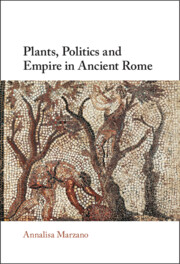Figures
1.1Castellammare di Stabia (Italy): Villa S. Marco, view of the lower peristyle garden with pool, replanted plane trees, and casts of ancient root cavities of plane trees. Photo by Bildagentur-online / Universal Images Group Editorial / Getty Images.
3.1The villa of Livia, Prima Porta, Rome: Wall painting with garden scene from one of the walls of the underground triclinium of the villa ad Gallinas Albas, now in the Museo Nazionale Romano-Palazzo Massimo alle Terme, Rome. Photo by Leemage / Corbis Historical / Getty Images.
3.2Drawing of CIL 6.1261, a lost inscription which used to be in the church of S. Maria on the Aventine, Rome. The inscription attests to a public–private agreement for water distribution. Drawing by Mehmet Deniz Öz.
4.1Saint-Germain-en-Laye, France: the grafting of a tree, detail of one of the vignettes making a large mosaic floor depicting an agricultural calendar, first half of the third century ad. Photo © RMN-Grand Palais-Musée d’Archéologie Nationale / Michel Urtado.
4.2Castellammare di Stabia (Italy): Villa Arianna, plan of excavated garden in the Great Peristyle showing planting beds, walkways and root cavities. Courtesy of Thomas N. Howe and Kathryn Gleason.
5.1Herculaneum, House of the Stags: wall painting depicting three still lives with fruit, including branches of peaches, now in the Naples National Archaeological Museum, inv. 8645. Photo by Luigi Spina / Electa / Mondadori Portfolio / Hulton Fine Art Collection / Getty Images.
7.1Map of the Iberian Peninsula illustrating the distribution in percentage of the different groups of archaeobotanical taxa preserved by charring, as presented in Peña-Chocarro et al. 2017. Courtesy of Leonor Peña-Chocarro and her co-authors.
7.2Map of the Iberian Peninsula illustrating the distribution in percentage of the different fruit species preserved by charring, as presented in Peña-Chocarro et al. 2017. Courtesy of Leonor Peña-Chocarro and her co-authors.
8.1Pompeii, garden of the Casa della Regina Carolina (viii.3.14): close-up of planting pot (olla perforata) in the middle of a planting pit during excavation in summer 2019. © The ‘Casa della Regina Carolina Project’ / Parco Archeologico di Pompei; photo: Danielle Vander Horst.
8.2Aerial photo of the Roman orchard excavated at Champ Redon, near Valros, France, showing the rows of planting pits. Photo: MRW Zeppeline-Inrap (Institut national de recherches archéologiques préventives), courtesy of Cécile Jung and Inrap.

